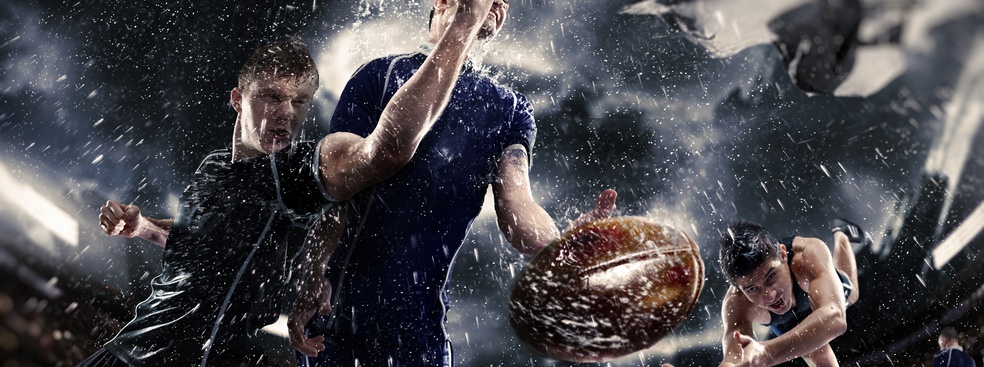With ESSEC Knowledge Editor-in-chief
With the Rugby World Cup this fall, fans are flocking to France from all over the world to cheer on their team. France’s star player Antoine Dupont captained les Bleus to the quarter-finals before getting knocked out by South Africa - this after suffering a fractured cheekbone and undergoing major surgery earlier in the tournament. Rugby players are no strangers to this type of injury - the field is dotted with players wearing “scrum caps” to protect from cauliflower ears and violent tackles are the name of the game. Why are we drawn to watching such a violent sport, when we know people are likely to get hurt? Delphine Dion (ESSEC Business School), Clément Dubreuil (Kedge Business School) and Stéphane Borraz (NEOMA Business School) explored this question, finding that viewers experience a sort of moral ambivalence and justify the violence as they watch.
Rugby isn’t alone in this, either: American football, ice hockey, mixed martial arts and wrestling are other examples of violent contact sports that continue to enjoy popularity. In these sports, violence isn’t just incidental, it’s a key part of the game. Past research showed this violence cultivates emotional contagion and appeals to our baser instincts. This can lead to a confusing experience for the viewers, who enjoy watching even though they know violence is wrong. So what makes violence acceptable - and enjoyable - in sports?
To better understand this contradiction, the researchers conducted 21 interviews with consumers (rugby fans) and nine with professionals in the rugby world and analyzed social media posts.
All’s fair in love and war
In their interviews, the researchers found that the interviewees often used war metaphors and vocabulary when describing rugby, a form of “translating” one reality (rugby) to another (war) by dramatizing the violence. This type of thinking can also be seen in New Zealand's traditional haka, traditionally performed by Maori warriors before a battle. All of this means that rugby is often seen as a war-like alternative reality, one where violence is fêted and justified. Violence is seen as the players fulfilling their duty and benefiting the community - defending their team and not letting the fans down.
It’s just a game!
At the same time, this dramatization of violence is linked to also de-dramatizing the violence, and justifying it as “just a game”. Interviewees noted that it’s just for fun, and to win, with fans and players playing this up with songs and performances that poke fun at the violence. For example, the Stade Français has introduced pink, leopard print, floral, and other fun jersey patterns, to lighten the mood. While these might be parodies of violence, they do also normalize and justify it, by suggesting it’s not so bad and actually can be funny.
It’s how it is
Another way that people justify the violence in rugby is by saying it’s the rules of the game. As long as a play is allowed, then it’s acceptable. One spectator explains: “You also have to distinguish between the pain inflicted by players who give their best and who are aggressive but play by the rules—which is all part of the game—and the pain that results from the actions of players who deliberately break the rules. [...]. When it is in the course of the game, when he is doing nothing wrong, a player who hurts another is doing his job, there is nothing to blame him for.” This is a common experience: when we encounter moral ambivalence, we look to the rules set out by what we see as legitimate institutions, in this case World Rugby. That being said, other spectators expressed concern about rising levels of violence and suggested the rules might need to change to curb this phenomenon. Instead of accepting the rules, they challenge them and suggest that new ones are needed. People also trust the official representatives, such as the referees, to enforce these rules. If the referees are seen as too lax, then the violence is more likely to be seen as inappropriate.
Lights, camera, action
All the world’s a stage, and rugby is no different. The game’s broadcast plays a big role in how we perceive the match and thus the violence. Certain plays are shown over and over again, in slow motion and with freeze frames, whereas others can be shown only at a distance. When players are injured, they are surrounded (and therefore hidden) by medical staff, or even covered with a white sheet. When injuries are talked about, it’s often using euphemistic language: “it stings” rather than “it hurts”, for example.
Broadcasting can even make violence aesthetic. Commentators often use language like beautiful and nice when describing the action, and #beaugeste (beautiful move) and #beaujeu (beautiful game) are popular hashtags during a game. There’s a big focus on the “art of the game”, with one spectator describing this as: “There is a beauty to rugby. It’s a bit like the Greek aesthetic of masculine strength, it exalts the group spirit. Like the Spartans, or Roman soldiers: the beauty of a well-ordered army, where everything is efficient.” This can result in a perception that violence is beautiful. All of this contributes to camouflaging the consequences of the violence and producing a distorted vision of it.
This study suggests that market players (fans, players, broadcasters, etc.) use different justifications to resolve the moral ambivalence of violence, by telling themselves that it’s like a battle, that there are rules to be respected, and that the game is a thing of beauty. These different strategies allow them to rationalize that the violence in rugby is okay, even though they wouldn’t accept violence in another context.
Where to go from here?
While it may indeed be “just a game”, the rising levels of violence and associated injuries do give reason for concern. The researchers suggest three strategies to mitigate this:
-
Contextualizing: Competition organizers and broadcasters should think about how they contribute to normalizing violence, for example by showcasing the players as warriors. They should avoid using war references and parodies, and focus instead on player performance and technique.
-
Ruling: Since many market players justify the violence by referring to the rules, governing bodies should commit to regularly reviewing the rules to prevent high levels of injury. One example is that of spear tackles, a once widely accepted move that is now banned to protect players.
-
Broadcasting: Policymakers and broadcasters have the opportunity to collaborate and produce a charter of responsibility when showing contact sports. This could reduce the distortion of violence and avoid glorifying it, by using direct language that properly describes injuries and pain, offering filters to avoid viewing violent content (particularly for young fans), and access additional content that explains the real risk of violence and injuries. This also concerns social media like YouTube, which compile short, violent and spectacular sequences taken from rugby games and totalize millions of views.
Violent sports aren’t going anywhere: the Rugby World Cup 2023 has already drawn in 164.5 million viewers, and the tournament isn’t over yet. With so many eyes on the sport, it’s important to understand how people justify that this violence is acceptable even when it’s not in other contexts, giving us insight into the complicated human psyche.
To go further:
Dubreuil, C., Dion, D., & Borraz, S. (2023). For the love of the game: moral ambivalence and justification work in consuming violence. Journal of Business Ethics, 186(3), 675-694.







